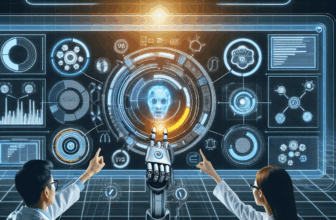Revolutionizing Product Launches: How AI-Driven Strategies Enhance Success and Efficiency
Table of Contents
- 1. Introduction
- 2. Understanding AI in Product Launches
- 3. Pre-Launch Strategies
- 4. Launch Strategies
- 5. Post Launch Evaluation and Feedback
- 6. Real-Life Case Studies
- 7. FAQs
- 8. Conclusion
- 9. Resources
- 10. Disclaimer
1. Introduction
The advent of artificial intelligence (AI) has transformed various aspects of business operations, one of which is the product launch process. Companies no longer rely solely on traditional marketing tactics to introduce their products to the market. Instead, they leverage AI-driven strategies that enhance both success and efficiency. In this in-depth exploration, we will discuss how AI is revolutionizing product launches, encompassing everything from pre-launch strategies to post-launch evaluation.
2. Understanding AI in Product Launches
2.1 What is AI?
Artificial Intelligence (AI) is the simulation of human intelligence processes by machines, especially computer systems. These processes include learning (the acquisition of information and rules for using it), reasoning (using the rules to reach approximate or definite conclusions), and self-correction. AI can be categorized into two main types: narrow AI, which is designed to perform a narrow task (like facial recognition or internet searches), and general AI, which possesses the ability to perform any intellectual task that a human being can do. In the context of product launches, AI primarily falls under narrow AI, employing algorithms to analyze data and help businesses make informed decisions.
2.2 AI Technologies Used in Product Launches
Various AI technologies are implemented to enhance product launch strategies. Key technologies include machine learning, natural language processing (NLP), and predictive analytics. Machine learning algorithms analyze patterns in data, enabling businesses to gain insights and predictions regarding consumer behavior. Natural Language Processing leverages AI to understand and process human languages, which is invaluable in customer communication and sentiment analysis. Predictive analytics applies statistical algorithms and machine learning techniques to identify the likelihood of future outcomes based on past data.
3. Pre-Launch Strategies
Preparing for a product launch is a meticulous process, and AI can enhance various activities during the pre-launch phase, ensuring that businesses are well-equipped for success.
3.1 Market Research
AI-powered tools can streamline market research by processing vast amounts of data in a fraction of the time it would take human analysts. These tools can sift through social media, forums, blogs, and other online platforms to gather consumer opinions on products, services, and industry trends. By analyzing sentiment and gathering demographic data, businesses can identify gaps in the market, emerging trends, and audience preferences.
3.2 Target Audience Identification
Identifying the right audience is crucial for a successful product launch. AI algorithms can analyze customer purchase behavior, online interactions, and demographic data to segment potential customers. Advanced customer profiling allows businesses to tailor their marketing strategies to resonate with specific audience segments, improving engagement and conversion rates during the launch phase.
3.3 Product Development Assistance
AI can play a significant role in product development by simulating different product designs and configurations. By utilizing AI-powered modeling tools, companies can gather real-time feedback on product features and design aspects. These models predict how changes in product attributes might affect customer demand, enabling businesses to make informed decisions during the product development cycle.
4. Launch Strategies
During the launch phase, AI-driven strategies can further enhance engagement, reach, and overall effectiveness.
4.1 Personalization of Marketing Efforts
AI enables businesses to deliver personalized marketing messages based on consumer data and behavior. By analyzing past purchasing behavior and online activity, AI systems can recommend personalized product offerings and create targeted advertising campaigns. Personalization fosters a deeper connection with customers, enhancing the likelihood of successful conversions during the launch phase.
4.2 AI in Content Creation
AI tools can assist in content creation by automating tasks such as copywriting, graphic design, and video editing. Natural Language Generation (NLG) uses algorithms to create human-like text, including blog posts, product descriptions, and promotional content. This technology saves time and resources while maintaining a high-quality output, allowing teams to focus on strategy and execution during the launch.
5. Post Launch Evaluation and Feedback
After launching a product, evaluation and feedback are essential to gauge the effectiveness of the launch and identify areas for improvement.
5.1 Data Analysis
Data analysis continues to play a critical role following a product launch. AI can swiftly analyze sales data, social media engagement metrics, and customer feedback to assess the overall performance of the product. Predictive analytics can also forecast future sales trends, helping businesses adapt their strategies in real-time.
5.2 Customer Feedback Analysis
Gathering and interpreting customer feedback is vital for continuous improvement. AI-driven sentiment analysis can categorize customer reviews and feedback, providing insights into public perception and satisfaction levels. This enables businesses to identify common pain points and adapt their offerings or marketing strategies accordingly.
6. Real-Life Case Studies
To further illustrate the effectiveness of AI in product launches, let's examine several case studies of companies that have successfully implemented AI-driven strategies.
6.1 Case Study: Coca-Cola
Coca-Cola used machine learning and AI for its product launches, optimizing marketing strategies by analyzing customer data. The company's AI-driven analysis of social media conversations helped them identify key trends driving consumer preferences, effectively positioning their products to appeal to younger audiences.
6.2 Case Study: Unilever
Unilever utilized AI technology to streamline its product development and launch processes. By using AI to analyze consumer behavior and preferences, they were able to predict which product features would resonate most with consumers, resulting in a successful launch of new product lines.
7. FAQs
Q: How can AI improve the efficiency of product launches?
A: AI enhances efficiency by automating market research, enabling precise target audience identification, optimizing product development processes, and analyzing feedback faster than traditional approaches.
Q: Is AI suitable for small businesses?
A: Yes, AI tools are accessible for businesses of all sizes. While the technology may seem more applicable for larger enterprises, many affordable AI solutions exist, tailored specifically for small businesses.
Q: What ethical considerations should businesses keep in mind when using AI?
A: Businesses must consider data privacy, the transparency of AI processes, and the potential for algorithmic bias. It's essential to implement AI responsibly and ethically, ensuring consumer trust is maintained.
8. Conclusion
The integration of AI-driven strategies in product launches holds incredible potential to revolutionize how businesses approach the market. From developing products tailored to consumer needs to launching them with personalized marketing strategies, AI contributes to improving both efficiency and success rates. As businesses continue to adopt these technologies, we expect further evolution in AI capabilities and applications, promising even greater advances in the future of product launches.
9. Resources
| Source | Description | Link |
|---|---|---|
| McKinsey & Company | Research on the impact of AI on marketing strategies. | McKinsey Insights |
| Gartner | Reports on AI innovation within product management. | Gartner IT |
| Harvard Business Review | Articles related to AI, innovation, and product launch strategies. | Harvard Business Review |
10. Disclaimer
This article is produced by A.I. and is in Beta Testing. The content is intended for informational purposes and is not a substitute for professional advice. Please consult with a qualified expert for specific guidance related to your business needs.










